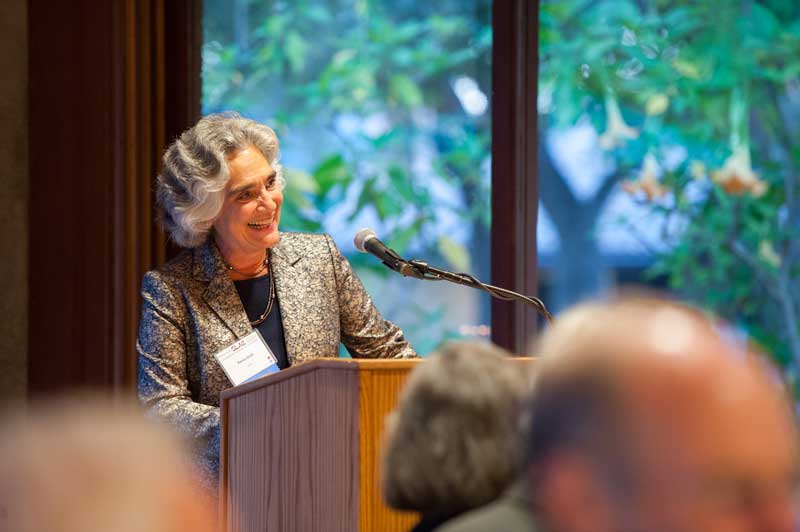by Rachel Kaufman

Like any good scientist, Persis Drell likes to ask questions.
The director of Stanford’s school of engineering and former director of the SLAC National Accelerator Laboratory in fact started her tenure as SLAC’s director by asking a series of intentionally provocative questions, like whether the U.S. even needed SLAC at all. (Spoiler alert: she believes it does—but felt it was important to ask the question.)
Such is par for the course for Persis Drell, whose leadership in the international particle physics community is renown. A new physics instrument is an opportunity to ask more questions. And running an engineering school, even one as well regarded as Stanford’s, is an opportunity to ask: What should we be doing differently?
Early life
The daughter of noted physicist Sidney Drell, Persis literally grew up on the Stanford campus, in one of the original 12 homes that Leland Stanford built for faculty. (It’s now the school’s Sexual Harassment Policy Office, Drell said last year.)
Physicists would drop by the Drell household and stay late into the night—physicists like Hans Bethe, Richard Feynman, and T.D. Lee. Drell said in a 2015 interview, “I wasn’t interested in the physics, but the people were fascinating.
“I would sit in the corner and just hope that no one would see me and send me to bed,” she said in a 2008 interview. “And I would just listen. And watch.”
In that environment she grew up surrounded by physics, but wasn’t interested in the field at first. In fact, she said, she “tracked low” in math in seventh grade and had a “horrendous” high-school physics class. But Wellesley professor Phyllis Fleming inspired her to pursue physics. “I took every course Miss Fleming taught,” she said. And then she took graduate-level physics courses at MIT while still an undergrad. And then she was hooked.
Back to Stanford
After more than a decade teaching at Cornell, she was pulled back west to teach at Stanford and serve as an associate director for SLAC, the national accelerator laboratory run by Stanford. Five years later, she was running the place.
It was not an entirely easy transition. According to Symmetry magazine, about 18 months after agreeing to serve as SLAC’s deputy director, she was ready to return to pure research. But then the center was hit by waves of layoffs and budget cuts, and Drell felt that “a new person coming in would have had a very difficult time doing what we had to do.”
She ended up being instrumental in helping SLAC transition from a solely high-energy-physics-focused enterprise to one seen as a leader in multiple scientific disciplines. The Linac Coherent Light Source, the world’s first X-ray free-electron laser, came online during her tenure, and scientists are now using it to do everything from studying crystal formation to watching shockwaves in diamonds to developing better blood pressure drugs.
“We have a tool whose capability we really haven’t fathomed yet,” she said in a 2008 interview. “I really believe the Nobel Prizes on [the LCLS] are going to be won for experiments we haven’t thought of yet, because the tool itself is so transformational.”
Through it all Drell has also served as a mentor, especially for other women rising up in the ranks of a very male-dominated field. “She didn't really hide the fact that her family life was important to her,” Ritchie Patterson, a Cornell professor who was Drell’s first postdoc, told Symmetry. “So she would move the seminar half an hour earlier so she could pick her kids up from daycare. There were plenty of fathers who needed to go pick up their kids, too, but who hadn’t done anything about it or who snuck out early. I think it was probably a welcome change for an enormous number of people.”
To deanship
In 2014, Drell accepted the position of dean of the Stanford School of Engineering—again, reluctantly at first, as she wanted to stay focused on teaching and research. But after meeting the “extraordinary” search committee, she changed her mind.
As dean, she almost immediately began an effort to define the next 20 years of the school. “We must avoid becoming complacent and continue to move forward. I don’t know what the school will be like in 15 years; I just know it will be different,” she said last year. So far those questions are unanswered, but certainly Drell will keep asking them until she finds answers.